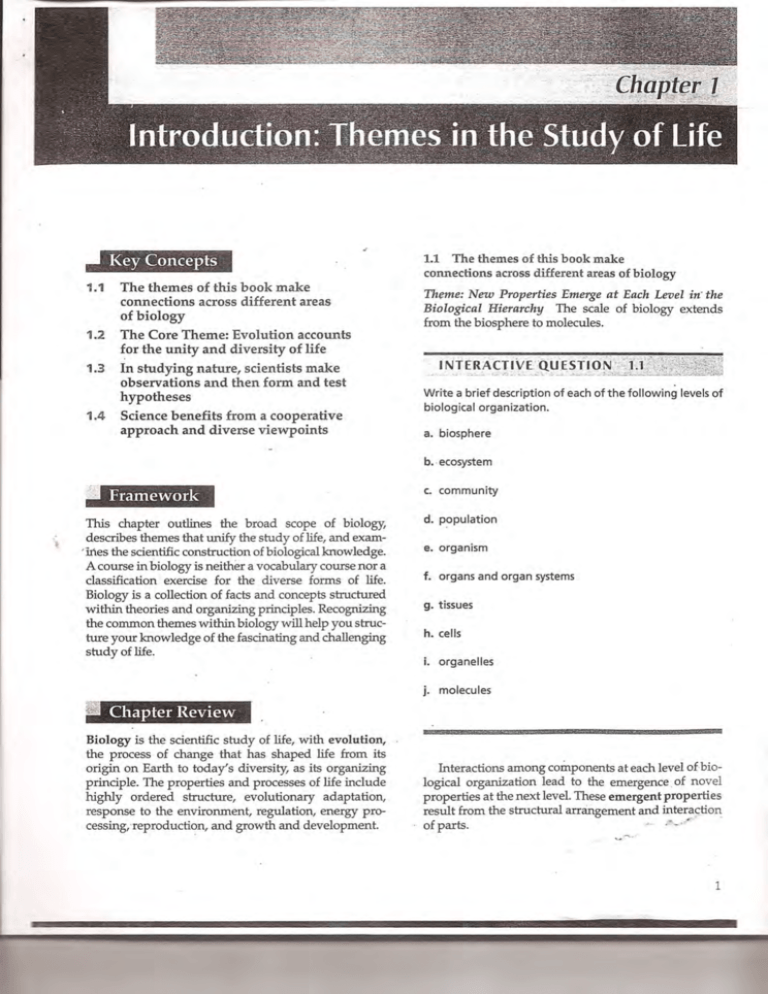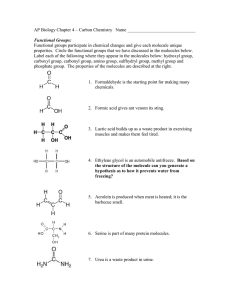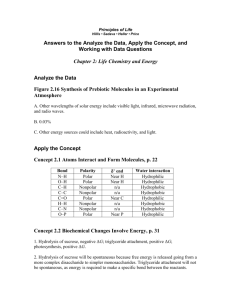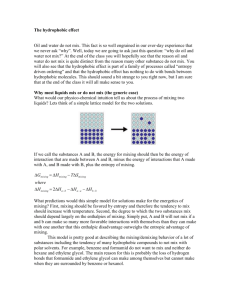AP Biology Review and Assignment
advertisement

Study Guide Answers Chapter 1 name_______________________________________ This chapter discusses many general ideas and themes in biology that will be revisited in detail in later chapters. Vocabulary- emergent properties, systems biology, genomics, negative feedback, positive feedback Interactive question 1.1 a. biosphere-_____________________________________________________________________________________ b. ecosystem-_____________________________________________________________________________________ c. community-_____________________________________________________________________________________ d. population-_____________________________________________________________________________________ e. organism-_____________________________________________________________________________________ f. organs and organ systems-________________________________________________________________________ g. tissues-________________________________________________________________________________________ h. cells-__________________________________________________________________________________________ i. organelles-_____________________________________________________________________________________ j. molecules-_____________________________________________________________________________________ Interactive question 1.2 Medical practice--___________________________________________________________________________________ Environmental policy--_______________________________________________________________________________ Interactive question 1.3-_____________________________________________________________________________ _________________________________________________________________________________________________ _________________________________________________________________________________________________ Interactive question 1.4-_____________________________________________________________________________ _________________________________________________________________________________________________ _________________________________________________________________________________________________ Interactive question 1.5-_____________________________________________________________________________ Interactive question 1.6-_____________________________________________________________________________ Interactive question 1.7 a.________________________________________________________________________________________________ b.________________________________________________________________________________________________ Interactive question 1.8 a.________________________________________________________________________________________________ b.________________________________________________________________________________________________ Structure your knowledge (briefly summarize the themes) a. emergent properties____________________________________________________________________________ b. interactions- biotic and physical_____________________________________________________________________ c. energy transfer and transformation__________________________________________________________________ d. structure and function ____________________________________________________________________________ e. cells ___________________________________________________________________________________________ f. heritable information ____________________________________________________________________________ g. feedback mechanisms ____________________________________________________________________________ h. evolution _______________________________________________________________________________________ Multiple choice 1_____ 2_____ 4_____ 5_____ 6_____ 7_____ 8_____ Chapter 2 Study guide answers name__________________________________ Vocabulary- It is assumed you know all basic chemistry vocabulary. Interactive question 2.1 These are the most important elements in organisms after C, H, O, and N. Ca _______________________ P_______________________ K______________________ S_______________________ Na_______________________ Cl______________________ Mg_____________________ Interactive question 2.2 ______________________, _________________________, ______________________________, ______________________________, _______________________________ Interactive question 2.3 __________________________________, __________________________________ Interactive question 2.4 7N 6C 8O 12Mg Interactive question 2.5 a. ____________________________ d.____________________________ g.____________________________ b.____________________________ e.____________________________ h.____________________________ c.____________________________ f.____________________________ atomic number valence shell electrons isotopes protons i._____________________________ element mass number element neutrons Interactive question 2.6 a. H __________ O ____________ C____________ N____________ H2 O2 N2 CH4 Interactive question 2.8 a.__________________ b.______________________ c._____________________ d.___________________ Interactive question 2.9 a._______________________________ b.__________________________________Interactive question 2.10 Interactive question 2.12 C6H12O6 + ______O2 → ____ CO2 + _____ H2O Multiple Choice 1_____ 2_____ 3_____ 4_____ 5_____ 6_____ 7_____ 8_____ 9_____ 10_____ 12_____ 13_____ 14_____ 15_____ 16_____ 17_____ 18_____ 19_____ 20_____ 24_____ 25_____ 26_____ 27_____ 28_____ 29_____ 30_____ Chapter 3 study guide answers name________________________ Vocabulary- cohesion, adhesion, specific heat, heat of vaporization, hydration shell, hydrophilic, hydrophobic, mole, buffers Interactive question 3.1 Interactive question 3.2 a._________________________________ d_____________________________ g.______________________________ b._________________________________ e._____________________________ h.______________________________ c._________________________________ f._____________________________ ice forms absorbed rain released polar water molecules heat of vaporization solar heat specific heat evaporative cooling Interactive question 3.3 a. olive oil _______________, ________________ c. salt _____________________, _____________________ b. sugar _______________, ________________ hydrophilic or hydrophobic, d. candle wax ___________________, ____________________ polar covalent, nonpolar covalent, or ionic Interactive question 3.4 a. _____________________________ b. ____________________________ Interactive question 3.6 H2CO3 ↔ HCO3- a. ______________________________________ + H+ b.______________________________________ Structure your Knowledge 1. Property Explanation of property Hydrogen bonds hold water molecules together and adhere them to hydrophilic surfaces High specific heat Example of benefit to life Temperature changes in environment and organisms are moderated Hydrogen bonds in water must be broken in order for water to evaporate Water molecules with high kinetic energy evaporate, remaining water molecules are cooler Less dense as a solid Most chemical reaction in life involve solutes dissolved in water Multiple choice 1____ 2____ 3____ 4____ 5____ 6____ 7____ 8____ 9____ 10____ 11____ 12____ 13____ 14____ 15____ 16____ 17____ 18____ 19____ 20____ 21____ 23____ 24____ Chapter 4 study guide answers name_____________________________________ Vocabulary- hydrocarbons, isomers , structural isomer, cis-trans isomers, enantiomers, asymmetric carbon, functional groups, Interactive question 3.1 _____________________________________________________________________________ __________________________________________________________________________________________________ Interactive question 3.2 The structural isomers are ____________________________ and ______________________________________ The cis-trans isomers are __________________________ and _____________________________________. The enantiomers are _____________________________________ and _______________________________________ Structure your Knowledge Chemical group Molecular formula -OH Characteristics of compounds with this group Aldehyde or ketone, polar group carboxyl -NH2 Thiols, cross-links stabilize protein structure phosphate -CH3 Multiple choice 1____ 2____3____4____5____6____ 8____ 9____ 10____ Multiple choice 1_______2_______ 3______4_______ 5_______6______7_______8_______9_______10_______11_______12_______ Chapter 5 study guide answers name___________________________ Vocabulary- macromolecules, monomer, dehydration reaction, hydrolysis, enzymes, saturated and unsaturated fats, protein structure, denaturation, pyrimidines, purines, Interactive question 5.1 Monomers are linked into polymers by ____________________________, which involves the ________________________________ of a water molecule. Polymers are broken down to monomers by ___________________________________ which involves the _________________________ of water. Interactive question 5.2 You can recognize a monosaccharide by its multiple _______________________________ groups and its one ___________________________ group whose location determines whether the sugar is an _________________________ or a _____________________________. In aqueous solutions, most five and six carbon sugars form ________________________________. Interactive question 5.3 Number the carbons in the glucose molecules (each unlabeled corner of the ring is a carbon). Circle the atoms that will be removed in a dehydration synthesis, then draw the resulting maltose molecule withs its 1-4 glycosidic linkage. Interactive question 5.4 a______________________________ e_____________________________ i_________________________________ b______________________________ f______________________________j_________________________________ c_______________________________ g____________________________ k_________________________________ d_______________________________ h_____________________________l_________________________________ chitin monosaccharides cellulose CH2O starch energy compounds animals polysaccharides carbon skeletons, monomers disaccharides glycosidic linkages glycogen Interactive question 5.5 Sketch a phospholipid bilayer of a membrane and label the hydrophilic head and hydrophobic tail. \ Interactive question 5.6 a______________________________ e_____________________________ i_________________________________ b______________________________ f______________________________j_________________________________ c_______________________________ g_____________________________ d_______________________________ h_____________________________ fats. Triglycerides animal cell membrane component, cholesterol phospholipids steroids glycerol fatty acids saturated has double bonds unsaturated has no double bonds phosphate group cell membranes Interactive question 5.7 a Alanine Serine b Which is polar? ________________________________ c. What does the drawing represent? _________________________________________ Interactive question 5.8 a_________________________________________ c_____________________________________________ b_________________________________________ d______________________________________________ ionic bond sulfur bridge hydrogen bond hydrophobic interaction Interactive question 5.10 Label the three parts of the nucleotide. Indicate with an arrow where the phosphate group of the next nucleotide would attach to build a polynucleotide. Number the carbons of this pentose sugar. b. Is this a purine or pyrimidine? _____________________ How do you know? ________________________________ c. Is this DNA or RNA? ___________ How do you know? ___________________________________________________ Structure your knowledge Primary structure ___________________________________________________________________________ Secondary structure _________________________________________________________________________ Tertiary structure ___________________________________________________________________________ Quaternary structure ________________________________________________________________________ 2. Look at the molecules a-g. Which two would combine to form a fat? ____ and ____ Which would join to another with a peptide bond? _____ Which three would join to form a nucleotide? ______ , ______, and _____ Which two are carbohydrates? _____ and _____ Which molecule is a purine? _____ Which molecule is the monomer of a protein? _____ Which two groups would be joined by a phosphodiester bond? _____ and _____ Most non polar (hydrophobic) molecule _____ Identify the molecules (letter) Ribose_____ glycerol _____ fatty acid____ amino acid ____ phosphate ____ triose sugar ____ nitrogen base _____ Multiple choice 1____ 2____ 4____ 5____6____ 7____8____9____11____12____14____15____16____17____18____19____20____ 21____ 22____23____24____











